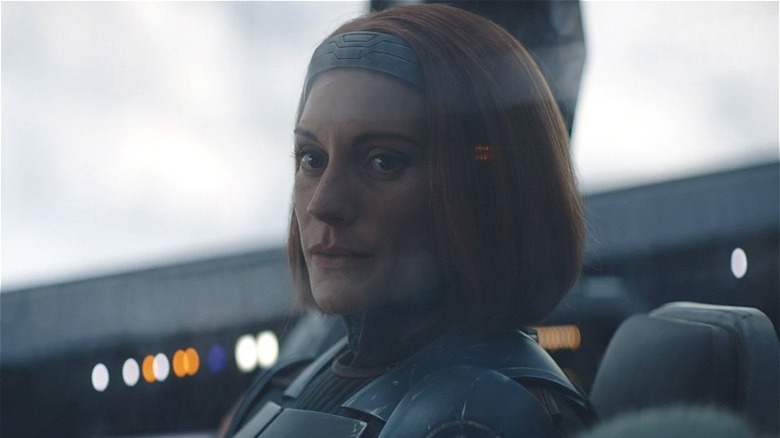The Mandalorian Season 3 Episode 2 Looks Great — And You Can Thank Director Rachel Morrison
This post contains spoilers for "The Mandalorian" season 3, episode 2 "The Mines of Mandalore."
Making a high-tech fantasy show appear both visually striking and tangibly convincing can be a tricky endeavor. Even objectively good pieces of media often struggle with proper lighting whilst depicting dimly lit sequences or nighttime scenes, making it impossible to tell what the heck is happening. Fortunately, this is not the case with the latest season 3 episode of "The Mandalorian," titled "The Mines of Mandalore," which is exactly where most of the key events take place — within the dark, dreary underground city of Sundari that Din Djarin (Pedro Pascal) and Grogu set out to explore.
Directed by Rachel Morrison, whose work as director of photography in "Mudbound" earned her an Oscar nomination for best cinematography, "The Mines of Mandalore" is a shining example of dimly lit fantasy sequences done right, wherein the episode's visual language greatly informs the narrative's tone and convincingly heightens emotional stakes.
Morrison is no stranger to working on bid-budget tentpole projects, as her work as a cinematographer for "Black Panther" allowed her to showcase her skills in making tense action moments intensely personal. Among the film's numerous stellar moments, the memorable T'Challa versus Killmonger fight stands out because of the scene's ability to convey the weight and scale of the confrontation, which Morrison helped shape with somber, yet refreshing lighting and color palette. Moreover, Morrison's collaboration with "Black Panther" director Ryan Coogler can be traced back to "Fruitvale Station," whose grounded and deeply empathetic visual fabric greatly elevates its subject matter.
Let us dive into how Morrison makes the latest episode of "The Mandalorian" impressive from a technical and aesthetic standpoint, which works in tandem to add layers to episodic lore and worldbuilding.
Action done right
Episode 2 opens with a string of outdoor sequences that play out in ways that are a staple for the show, with scenes set in Peli Motto's (Amy Sedaris) shop on Tatooine during Boonta Eve and the duo (along with R5-D4) traveling to Mandalore in the Razor Crest. The transition from these brightly-lit scenes to the dark dimness of the mines is accomplished in a way that feels natural and easy on the eyes — you do not need to squint to see who attacks whom after Mando and Grogu venture into the ruined city.
The moment Mando enters the entrance of Sundari, he is ambushed by a group of Alamites, who take him by surprise and proceed to attack him aggressively. The visual language of this scene is expertly crafted to convey the clumsiness with which Mando wields the Darksaber and barely manages to defeat the creatures, in stark contrast to Bo-Katan Kryze (Katee Sackhoff) expertly finishing off members of the same species moments later.
One of the episode's many highlights is when Mando is captured by the cyborg creature, and the camera gradually pans to the surroundings, detailing tell-tale signs that indicate that the duo walked straight into its lair. Every grim corner of the ruined city sports some sort of danger, which makes Grogu's impressive escape maneuvers doubly thrilling, given that the baby must now save his dad on his own.
Rachel Morrison deploys a deft interplay of light, shadow, and texture to make the treacherous nature of the mines more tangible, which intensifies the tragedy of Mandalore as a planet, which was once the center of culture and commerce. Bo-Katan's presence also lends more weight to the city's history, which naturally spills out in scenes detailing the ease with which she fights every adversary.
Adding weight to narrative revelations
Rachel Morrison's work as a cinematographer has always been visually intriguing, especially her ability to highlight thematic juxtapositions with the use of light and color alone. Rick Famuyiwa — who directed the season 3 premiere of "The Mandalorian — previously collaborated with Morrison on his coming-of-age drama, "Dope," which showcased Morrison's knack for perfectly complementing visuals with narrative aspects.
Morrison's strengths, both as a director and cinematographer, are in full display in the climactic Mythosaur scene towards the end of the episode when Mando is dragged underwater by the ginormous beast. The underwater aspect of this moment perfectly balances light and shadow — while nothing is crystal clear, we glimpse enough of the sea beast to understand the implications of its presence deep within the mines.
Moreover, this sequence is not just a visual treat. Apart from deepening the lore surrounding Mythosaurs, it directly impacts Mando and Bo-Katan's possible trajectories, along with the thousands of Mandalorians scattered across the galaxy. The fact that the duo is alerted to the creature's presence seconds after Mando indulges in the act of washing away his transgressions adds layers to his possible arc as a key figure instrumental in uniting his people. There's also a prophecy involving the Mythosaur, now unraveled as a future-altering truth to two Mandalorians who belong to different creeds but are working together out of mutual respect. This already feels like a turning point in Mandalorian history, where Djarin and Bo-Katan are currently standing on the precipice of change.
This scene also adds a greater edge to Bo-Katan's perennial badassery — not only does she save Mando from a menacing cyborg monster but also dives right into the Living Waters the moment he's pulled in, without hesitation. Will she emerge as the proverbial antithesis to Djarin? Only time will tell.


